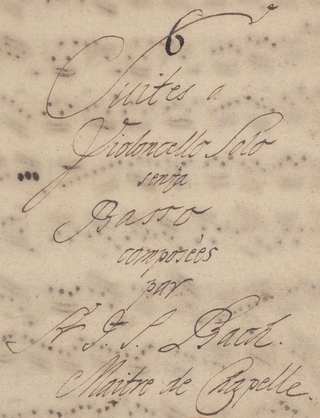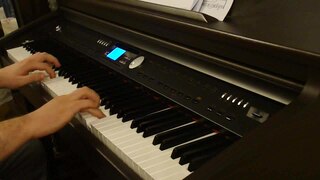
The six Cello Suites, BWV 1007–1012, are suites for unaccompanied cello by Johann Sebastian Bach (1685–1750). They are some of the most frequently performed solo compositions ever written for cello. Bach most likely composed them during the period 1717–1723, when he served as Kapellmeister in Köthen. The title given on the cover of the Anna Magdalena Bach manuscript was Suites à Violoncello Solo senza Basso.

The title Notebook for Anna Magdalena Bach refers to either of two manuscript notebooks that the German Baroque composer Johann Sebastian Bach presented to his second wife, Anna Magdalena. Keyboard music makes up most of both notebooks, and a few pieces for voice are included.

The sonatas and partitas for solo violin are a set of six works composed by Johann Sebastian Bach. They are sometimes referred to in English as the sonatas and partias for solo violin in accordance with Bach's headings in the autograph manuscript: "Partia" was commonly used in German-speaking regions during Bach's time, whereas the Italian "partita" was introduced to this set in the 1879 Bach Gesellschaft edition, having become standard by that time. The set consists of three sonatas da chiesa in four movements and three partitas in dance-form movements. The 2nd Partita is widely known for its Chaconne, considered one of the most masterly and expressive works ever written for solo violin.

The English Suites, BWV 806–811, are a set of six suites written by the German composer Johann Sebastian Bach for harpsichord and generally thought to be the earliest of his 19 suites for keyboard, the others being the six French Suites, the six Partitas and the Overture in the French style. They probably date from around 1713 or 1714.

The French Suites, BWV 812–817, are six suites which Johann Sebastian Bach wrote for the clavier between the years of 1722 and 1725. Although Suites Nos. 1 to 4 are typically dated to 1722, it is possible that the first was written somewhat earlier.

The four orchestral suites BWV 1066–1069 are four suites by Johann Sebastian Bach from the years 1724–1731. The name ouverture refers only in part to the opening movement in the style of the French overture, in which a majestic opening section in relatively slow dotted-note rhythm in duple meter is followed by a fast fugal section, then rounded off with a short recapitulation of the opening music. More broadly, the term was used in Baroque Germany for a suite of dance-pieces in French Baroque style preceded by such an ouverture. This genre was extremely popular in Germany during Bach's day, and he showed far less interest in it than was usual: Robin Stowell writes that "Telemann's 135 surviving examples [represent] only a fraction of those he is known to have written"; Christoph Graupner left 85; and Johann Friedrich Fasch left almost 100. Bach did write several other ouverture (suites) for solo instruments, notably the Cello Suite no. 5, BWV 1011, which also exists in the autograph Lute Suite in G minor, BWV 995, the Keyboard Partita no. 4 in D, BWV 828, and the Overture in the French style, BWV 831 for keyboard. The two keyboard works are among the few Bach published, and he prepared the lute suite for a "Monsieur Schouster," presumably for a fee, so all three may attest to the form's popularity.

Bourrée in E minor is a popular lute piece, the fifth movement from Suite in E minor BWV 996 written by Johann Sebastian Bach between 1708 and 1717. The piece is arguably one of the most famous among guitarists.
Johann Sebastian Bach composed suites, partitas and overtures in the baroque dance suite format for solo instruments such as harpsichord, lute, violin, cello and flute, and for orchestra.
The Overture in the French style, BWV 831, original title Ouvertüre nach Französischer Art, also known as the French Overture and published as the second half of the Clavier-Übung II in 1735, is a suite in B minor for a two-manual harpsichord written by Johann Sebastian Bach.

The Minuets in G major and G minor, BWV Anh. 114 and 115, are a pair of movements from a suite for harpsichord by Christian Petzold, which, through their appearance in the 1725 Notebook for Anna Magdalena Bach, used to be attributed to Johann Sebastian Bach. These minuets, which are suitable for beginners on the piano, are among the best known pieces of music literature. The 1965 pop song "A Lover's Concerto", of which millions of copies were sold, is based on the first of these Minuets.

The Partita No. 3 in E major for solo violin, BWV 1006.1, is the last work in Johann Sebastian Bach's set of Sonatas and Partitas. It consists of the following movements:
- Preludio
- Loure
- Gavotte en Rondeau
- Menuets
- Bourrée
- Gigue
Sophocles Papas was a Greek classical guitar pedagogue and music publisher.

The Bach-Busoni Editions are a series of publications by the Italian pianist-composer Ferruccio Busoni (1866–1924) containing primarily piano transcriptions of keyboard music by Johann Sebastian Bach. They also include performance suggestions, practice exercises, musical analysis, an essay on the art of transcribing Bach's organ music for piano, an analysis of the fugue from Beethoven's 'Hammerklavier' sonata, and other related material. The later editions also include free adaptations and original compositions by Busoni which are based on the music of Bach.

The Prelude in C Minor, BWV 999, is, according to its only extant 18th-century manuscript, a composition for lute by Johann Sebastian Bach. In the manuscript, conserved as Fascicle 19 of Mus.ms. Bach P 804 at the Berlin State Library, Johann Peter Kellner wrote the piece down in keyboard notation. The time of origin of the work is not known: possibly Bach composed it in his Köthen period, that is, between 1717 and 1723, or the early years of his ensuing Leipzig period. Kellner's copy was produced after 1727, but before Bach's death in 1750.
Suite in E minor, BWV 996, is a musical composition written by Johann Sebastian Bach (1685–1750) between 1708 and 1717. It is probable that this suite was intended for Lautenwerck (lute-harpsichord). Because the lautenwerk is an uncommon instrument, it is in modern times often performed on the guitar or the lute.
The Suite in C minor, BWV 997, by Johann Sebastian Bach, exists in two versions:









